#Meknès
Photo
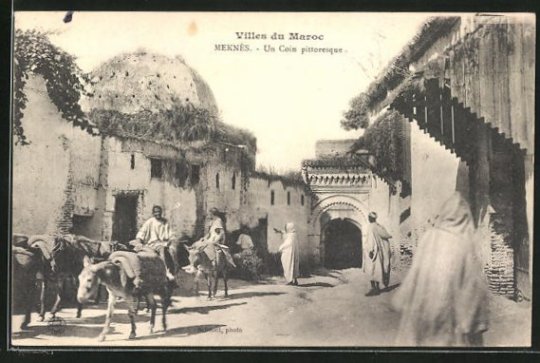
Villes du Maroc
MEKNÈS. - Un Coin pittoresque.
Alte Ansichtkarten.
#ⵜⴰⴳⵍⴷⵉⵜ ⵏ ⵍⵎⵖⵔⵉⴱ#المملكة المغربية#Morocco#ⴰⵎⴽⵏⴰⵙ#مكناس#Meknès#donkeys#postcard#carte postale#ansichtkarten
9 notes
·
View notes
Text
Marokko | Geschiedenis doordrenkt Meknès en Volubilis
Maandag, 11 maart 2024 | Het kleurrijke tapijt van Marokko, geweven met geschiedenis en doordrenkt met cultuur, onthult zijn pracht in de betoverende steden Meknès, Volubilis en Fez (Fès). De ANWB groepsreis door deze juweeltjes van het Maghreb-rijk is een ontdekkingstocht die zintuigen prikkelt en je geest verrijkt.
Meknès, de stille grootheid, begroet met zijn serene sfeer en imposante…
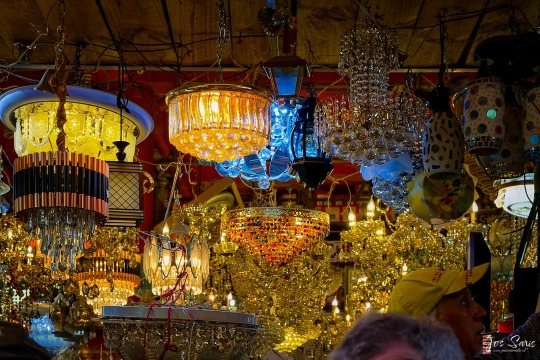
View On WordPress
#2024#ANWB Groepsreis#Fez#Jos Saris#Maghreb-rijk#Marokko#Mausoleum van Moulay Ismail#Medina#Meknès#Vimeo#Volubilis
0 notes
Photo
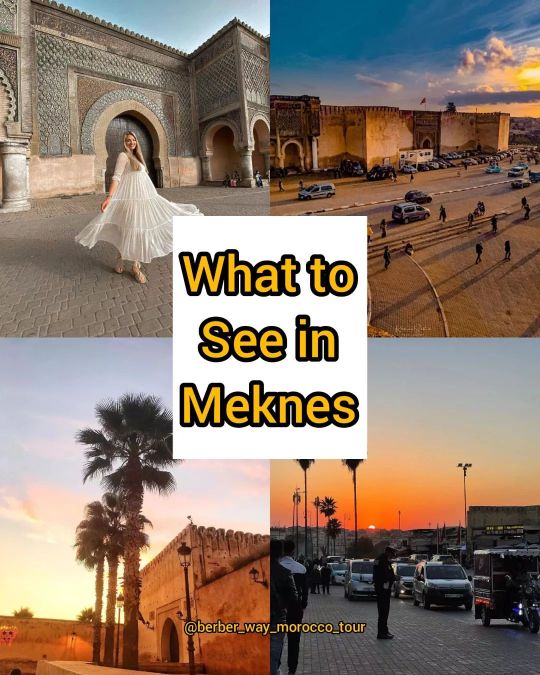
Plum in the Middle Atlas region of Morocco, Meknes is one of the country’s finest old imperial cities, enjoying status as the capital in the 17th century. It sees fewer tourists than nearby Fez – and it’s all the better for it, creating a perfect backdrop for a leisurely few days. With friendly people, fascinating historic sights such as the Mausoleum of Moulay Ismail and a lively scene after dark, don’t miss Meknes if you’re travelling in this part of Morocco. Here are the top things to see and do. 🔹The Mausoleum of Moulay Ismail 🔹Bab Mansour 🔹Enjoy the local vibe in at Place Hedim 🔹Visit an old prison with lots of history ... 🔹🔹🔹🔹🔹🔹🔹🔹🔹🔹 📧 Book your moroccan tours here: 🚩 Www.morocco-group-tours.com 📧[email protected] 📲 +212633987288 🔹🔹🔹🔹🔹🔹🔹🔹🔹🔹 CREDIT 👇 Use the tag and get featured! Tag us @berber_way_morocco_tour and use #moroccogrouptours Like what you see? FOLLOWG👉 Me 🔹🔹🔹🔹🔹🔹🔹🔹🔹🔹 #Morocco #Maroc #Marokko #Marruecos #Marrocos #摩洛哥 #марокко #מרוקו #meknes #meknès #méknes #meknescity #moroccotours #morocco_vacations #moroccotrip #travelmorocco #moroccovacations #المغرب #travelphoto #مراكش #travelbug #marrakech #fez #casablanca #merzouga #مكناس #مكناس_الغالية_العاصمة_الاسماعيلية #مكناسية (at Meknes) https://www.instagram.com/p/Cd5s-I7sCMF/?igshid=NGJjMDIxMWI=
#moroccogrouptours#morocco#maroc#marokko#marruecos#marrocos#摩洛哥#марокко#מרוקו#meknes#meknès#méknes#meknescity#moroccotours#morocco_vacations#moroccotrip#travelmorocco#moroccovacations#المغرب#travelphoto#مراكش#travelbug#marrakech#fez#casablanca#merzouga#مكناس#مكناس_الغالية_العاصمة_الاسماعيلية#مكناسية
0 notes
Text
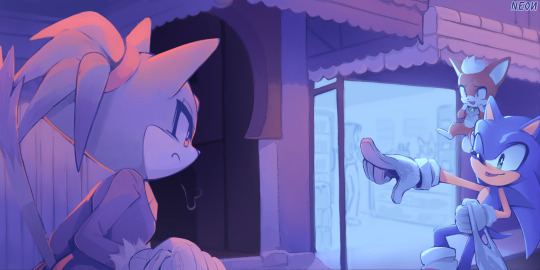
STH // To Meknes, Morocco! - Sonic World Adventure
My Illust for @sonicworldadventurezine !
#sth#sonic#sonic the hedgehog#sonic world adventure#sonic unleashed#blaze the cat#sonic fanart#12art#chip#light gaia#I chose to do an illustration w/ Meknès after I travelled to the city again for Eid Mawlid Al Nabaoui#the bg I chose is actually heavily based off of a street I passed through that weekend lmao#The colors on the other hand are inspired by the color of most street lamps here#They tend to give our cities a beautiful orange glow and I always loved how that looked whenever the sun would set#Also chose blaze cause I like thinking she's half moroccan
764 notes
·
View notes
Text

F E S
40 notes
·
View notes
Text
التسجيل في جامعة مولاي إسماعيل بمكناس 2022 2023
0 notes
Text
Thyreosaurus atlasicus Zafaty et al., 2024 (new genus and species)

(Armor plates of Thyreosaurus atlasicus [scale bars = 5 cm], from Zafaty et al., 2024)
Meaning of name: Thyreosaurus = shield lizard [in Greek]; atlasicus = from the Atlas Mountains
Age: Middle Jurassic (Bathonian–Callovian?)
Where found: El Mers III Formation, Fès-Meknès, Morocco
How much is known: Partial skeleton of one individual including several vertebrae, ribs, armor plates, and a limb bone.
Notes: Thyreosaurus was a stegosaur, possibly closely related to Adratiklit, which is also known from the Middle Jurassic of Morocco, and Dacentrurus from the Late Jurassic–Early Cretaceous of Europe. The type specimen is estimated to have been about 6 m long in total body length, but had not finished growing when it died.
The armor plates of Thyreosaurus were unusual in that they exhibit a cross-hatched texture on one side. In other armored dinosaurs, similar textures are generally found at the base of bony armor where it is embedded into their skin. The describers of Thyreosaurus thus suggest that these plates lay flat against its body, instead of standing vertically as is typical of back plates in other stegosaurs.
Reference: Zafaty, O., M. Oukassou, F. Riguetti, J. Company, S. Bendrioua, R. Tabuce, A. Charrière, and X. Pereda-Suberbiola. 2024. A new stegosaurian dinosaur (Ornithischia: Thyreophora) with a remarkable dermal armour from the Middle Jurassic of North Africa. Gondwana Research advance online publication. doi: 10.1016/j.gr.2024.03.009
64 notes
·
View notes
Text
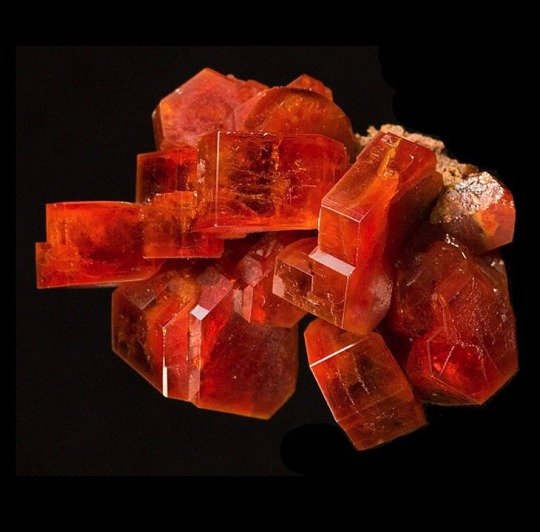
Vanadinite in cogwheel-like form from Mibladen Mine, Khénifra Province, Meknès-Tafilalet Region, Morocco
Photo: Robert M. Lavinsky
84 notes
·
View notes
Text
Jakapil vs Spicomellus
Jakapil kaniukura
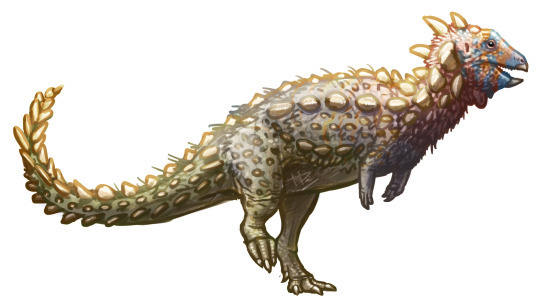
Artwork by @i-draws-dinosaurs, written by @zygodactylus
Name Meaning: Deep Jawed Shield Bearer
Time: 99 to 97 million years ago (Cenomanian stage of the Late Cretaceous)
Location: Candeleros Formation, Neuquen and Mendoza, Argentina
Jakapil is to nonavian dinosaurs as Annakacygna is to birds. This may seem extreme - what could possibly top the cup zoomy swan of filter feeding death - but Jakapil is a weird little dude. It was a bipedal armored dinosaur, similar to the Early Jurassic basal form Scutellosaurus - except, you’ll note, it lived a hundred million years later. At about 1.5 meters long, it was a small dinosaur, again similar to its relative from so long ago. It had rows of osteoderms on its body, and a predentary - unlike other early thyreophorans. It may have diverged from the main thyreophoran group in the Sinemurian, representing a lost lineage of bipedal armored forms that persisted (presumably in South America). However, its classification is a major debate among researchers - many features of the jaw are more similar to Ceratopsians than to Thyreophorans, indicating it may be an armored variant of an early Ceratopsian (which, would be, to say the least, wild) or a completely new clade of Ornithischian altogether! The large amount of wear on its teeth indicates it chewed its food, rather than sheering or chopping it - something only found in a few Ornithischian groups. It lived in a large desert environment, peppered with oases, and filled with a variety of other animals - fish, frogs, tuatara, snakes, turtles, mammals, and other dinosaurs like Andesaurus, Ekrixinatosaurus, Giganotosaurus, Buitreraptor, Alnashetri, and Bicentenaria.
Spicomellus afer
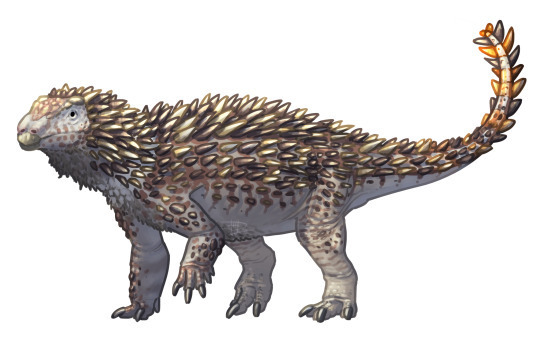
Artwork by @i-draws-dinosaurs, written by @zygodactylus
Name Meaning: African Collar of Spikes
Time: 168 to 164 million years ago (Bathonian to Callovian stages of the Middle Jurassic)
Location: Third Subunit, El Mers Group, Fès-Meknès, Morocco
Spicomellus is the oldest known Ankylosaur, and also the first described Ankylosaur from North Africa! But that isn’t even the weirdest thing about it! Spicomellus had dermal spikes, fused to the bone, forming a collar (for which it was named) around its neck. Given that the spike were fused to the underlying bone - something no other ankylosaur does - it is probable that it wouldn’t have had a particularly flexible neck, or an easy time moving in general if the pattern continued throughout the body. It probably would have been around 3 meter long at the most, similar in size to other ankylosaurs from the Middle Jurassic. Coming from the El Mers Group, i tlived alongside Cetiosaurus, the stegosaur Adratiklit, megalosaurs, and teleosaurids. Spicomellus adds to a growing diversity of Jurassic Ankylosaurs, showing how Ankylosaurs and Stegosaurs lived alongside each other for a large period of time (the Middle and Late Jurassic epochs) and that the extinction of the Stegosaurs must have been due to a different, unrelated factor.
#dmm#dmm rising stars#dinosaur march madness#dinosaurs#birds#birblr#palaeoblr#paleontology#march madness#bracket#polls#jakapil#spicomellus#round three
183 notes
·
View notes
Photo
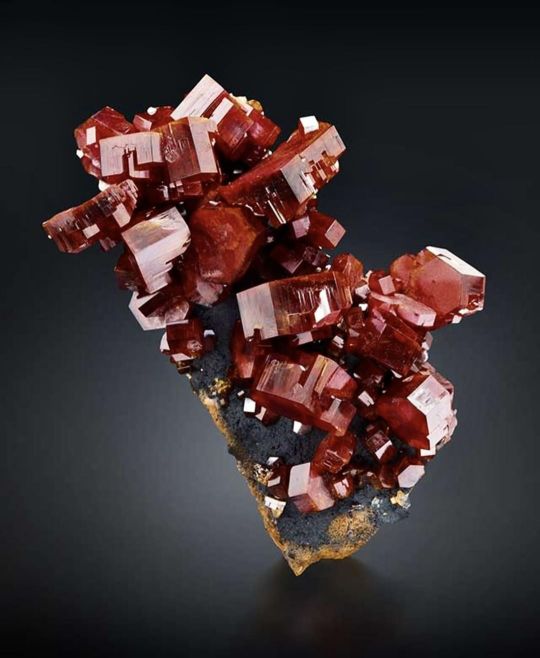
ID#: 01216, Vanadinite El Kwal, Mibladene, Khénifra Prov., Meknès-Tafilalet Region, Morocco Copyright ©️ mardani.fine.minerals #gemologist #crystal #quartz #aquamarine #Tourmaline #crystalcollection #khushall_minerals #crystalcollector #khushallcrystal #minerals_wholesale #mineralswholesale #quartzcollecting #crystallover #rock #khushallgems #gemstones #stone #dubanigems #minerals #ilovecrystals #crystals #khushalljewellery #mineralsforsale #gemsforsale #gemsshop #naturalstone #khushallfineminerals #crystalhealing #gems #tucsongemshow https://www.instagram.com/p/Cn3865Cosc4/?igshid=NGJjMDIxMWI=
#gemologist#crystal#quartz#aquamarine#tourmaline#crystalcollection#khushall_minerals#crystalcollector#khushallcrystal#minerals_wholesale#mineralswholesale#quartzcollecting#crystallover#rock#khushallgems#gemstones#stone#dubanigems#minerals#ilovecrystals#crystals#khushalljewellery#mineralsforsale#gemsforsale#gemsshop#naturalstone#khushallfineminerals#crystalhealing#gems#tucsongemshow
14 notes
·
View notes
Text
#morocco#turismo#nice view#best#nature#travel photography#nice place#destination#traveling#travel#places to visit in morocco#best places to visit in morocco#where to go in morocco#morocco travel#morocco travel vlog#morocco tourism#morocco history#top places to visit in morocco#places to visit in morocco 2023#best places to visit in morocco 2023#tourism in morocco#things to do in morocco#morocco itinerary#beautiful places to visit in morocco 2023#fun things to do in morocco#visit morocco#best places in morocco 2023#best things to do in morocco
2 notes
·
View notes
Text
Weg ins Paradies

Der 'Platz'
Marrakesch - verwirrend, exotisch, authentisch
„Die Stadt wird dich verführen!“, sagte ein Freund. Er sollte Recht behalten. Sie umfängt mich mit all ihren Reizen. Sinnlich und lasziv, duftend nach Safran, Jasmin, Rosenwasser und Minze, stinkend nach Kloake und Pisse. Im Stadtteil Gueliz gibt sie sich fashionable, drüben, in der Medina, als wäre sie im Mittelalter versunken. Marrakesch ist betörend schön und abstoßend hässlich, immer aber voll von Leben. Und Farben. Und Liebe. Verwirrend. Exotisch. Authentisch.

Am Jemaa el Fna Platz
Jede Herrscherdynastie schmückte sich mit einer anderen Blüte. Bei den Almoraviden, Almohaden und Saadiern war Marrakesch erste Stadt des Landes, die Alawiden setzten auf Meknès, die Idrisiden und Meriniden wieder erkoren Fès zur Hauptstadt. Heute regiert Mohammed VI. von Rabat aus über sein Land, trotzdem sich längst eine andere Stadt zur größten des Königreiches entwickelte: Casablanca. Immer noch also rittern die Königsstädte um die Gunst der Stunde - und um die der Touristen. Die „Rote Stadt“ Marrakesch aber trägt zweifellos den Sieg davon. Keine andere Stadt verbirgt ähnlich viel Liebreiz unter ihrer Takschita, wie sie. Lass dich betören, Fremder! Irre durch die schmalen Gassen der Medina, spaziere durch die prachtvollen Gärten, erobere das Labyrinth der Souks, entdecke Paläste und Hinterhöfe, folge herrlichen Gerüchen, und probiere all die geheimnisvollen Speisen aus den Kochbüchern von tausendundeiner Nacht. Marrakesch ist die Göttin des Maghreb.

Pferderennen vor der Koutoubia Moschee
Etwa zweihundert Kilometer von der Küste entfernt, liegt sie auf halben Weg zum Hohen Atlas, dem mächtigen Gebirgszug im Süden ihrer Stadttore. Während tagsüber die Hitze Afrikas den Menschen den Atem raubt, sind die Nächte kühl und trocken. Die aber verbringt man am besten in einem der gut verborgenen Privathäuser, genießt ihren orientalischen Luxus und lässt sich im Innenhof mit einem „Thé à la menthe“ verwöhnen.
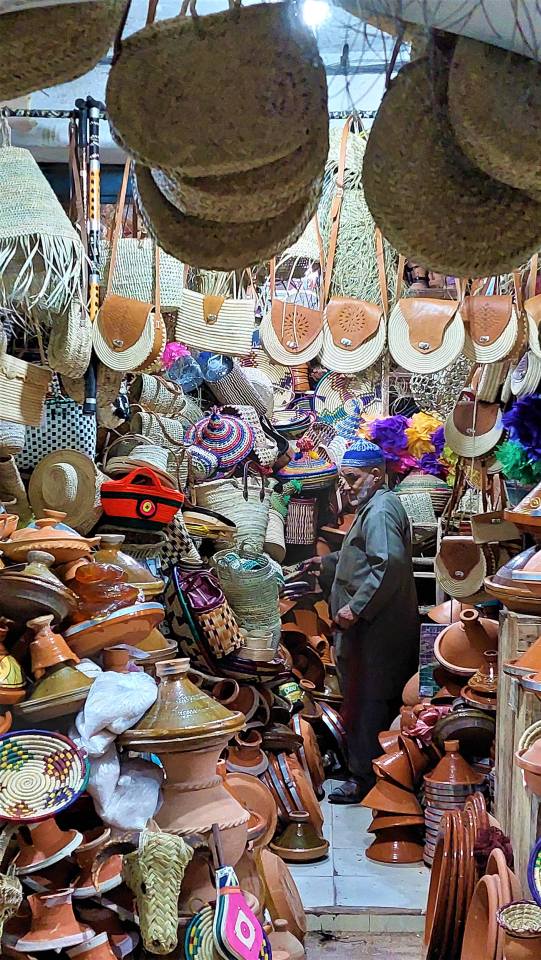
Im Souk
Marrakesch ist in jeder Beziehung eine Reise wert. Rituale und Hightech, Moderne und Tradition. All das findet der Reisende, kaum dass er den tiefgekühlten Airport Menara hinter sich lässt und eine Welt betritt, die aus Märchen, Mythen und jeder Menge Minzblätter besteht.
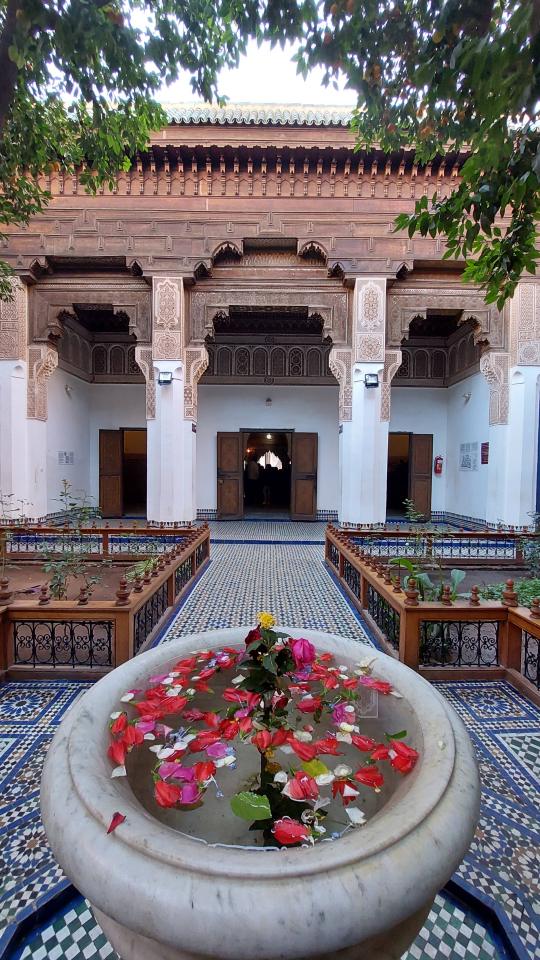
Bahia Palast
Moscheen und Paläste
Palais de la Bahia – „Die Strahlende“, wie der Palast genannt wird, ist eine grandiose Flucht von Sälen und Höfen. Eine exotische Welt, die allen Luxus orientalischer Herrscher bereithält
Koutoubia Moschee – Weithin schallt der Ruf des Muezzins, der vom hohen Minarett die Gläubigen zum Gebet ruft. A propos: Nicht-Muslimen ist der Eintritt in das, im maurischen Stil errichtete Wahrzeichen Marrakeschs verboten. Dennoch: Ansehen und bewundern – nur halt von außen
Palais El Badi – Die einst größte und prächtigste Palastanlage des Maghreb liegt inmitten einer Parkanlage und ist von einer stattlichen Mauer umgeben. Steinerne Zeugen längst vergangener Pracht
Medersa Ben Youssef – Das schönste Gebäude der Stadt. Die Koranschule umschließt einen beeindruckenden Innenhof, von dem aus sich ein Labyrinth aus unzähligen Räumen verzweigt
Koubba Ba’adiyn – Gegenüber der Ben-Youssouf-Moschee liegt ein Kleinod der besonderen Art: Die Koubba („Kuppel“) eines Pavillons, der sich Jahrhunderte lang unter der roten Erde verbarg
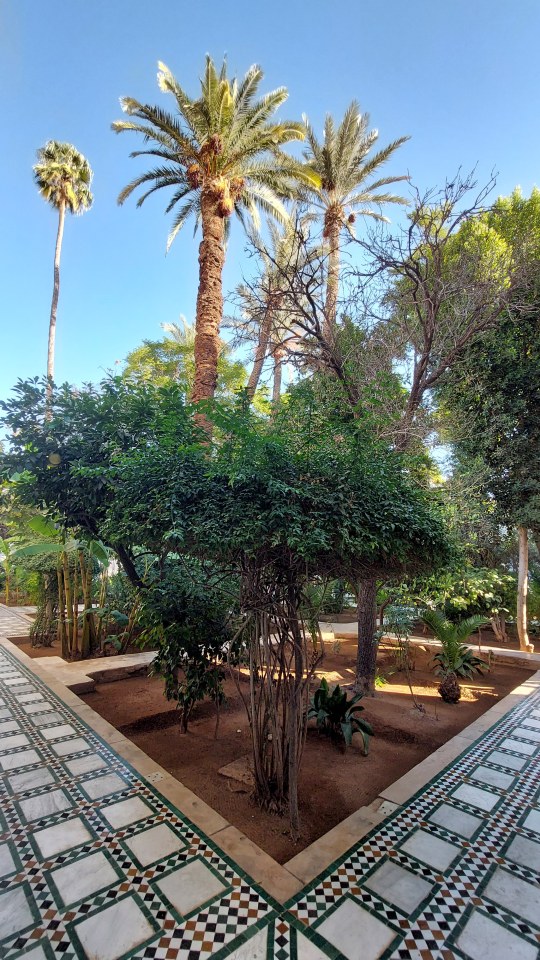
Garten im Bahia Palast, Marrakesch
Zu Gast im Riad
In einem der verzaubernsten Länder der Welt, lassen Connaisseure die Touristenhotels links liegen, und begeben sich auf die Suche nach dem „Paradies“. So und nicht anders lautet die wörtliche Übersetzung des Begriffes „Riad“. Gemeint ist eines jener unzähligen Stadtpalais, die sich hinter unscheinbaren Mauern verbergen, sodass es schon eine gehörige Portion Mut braucht, sich von einem der ortskundigen Guides durch das Labyrinth der schmalen Gassen führen zu lassen, um endlich vor einem, mit Eisennägeln verzierten Tor anzuhalten. Weder Hausnummer noch Türschild ist daran befestigt, weshalb auch, hier wohnen Einheimische, zu denen der Reisende ja schließlich gehören mag. Der Guide schlägt mit einem Klopfer gegen das Portal, worauf sich dieses wie von Zauberhand öffnet. Das Gezirpe aufgescheuchter Vögel, die in der Blütenpracht einer riesigen Bougainvillea Wache halten, der zarte Duft frisch geschnittener Rosen, das Plätschern des Springbrunnens in der Mitte des aus abertausenden Mosaiksteinen belegten Innenhofes, ein Kännchen mit heißem Pfefferminztee - all das beruhigt und beglückt den Neuankömmling und lässt den abenteuerlichen Anmarschweg vergessen. Man wird willkommen geheißen, nimmt Platz, genießt den Geruch von Orangenblüten und Patschuli, so wie den kühlenden Schatten, der vor den Sonnenstrahlen des heißen Tages schützt.
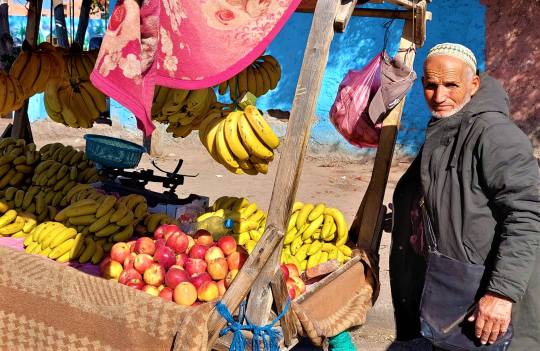
Am Markt El Gza
Viele Häuser wurden zusammengelegt und zu einem kleinen Stadtpalast umgestaltet. Hier, in dem von dicken Mauern umschlossenen Eiland, bleibt man nicht lange Gast – man fühlt sich bald schon wie zu Hause. Das Zimmer, das man bewohnen darf, geht auf den Innenhof, die übrige Welt bleibt außen vor. In den kühlen Räumen, die als Ess- und Frühstücksbereich genutzt werden, lebt die Vergangenheit des Landes. Holzdecken, Fresken, Kachelornamente verzieren die Säle, Pölster und Decken beschützen orientalische Möbeln, auf den Marmorböden liegen Berberteppiche, und im Kamin knistern an kühlen Abenden Holzscheite. Der Europäer staunt, der alternativ Reisende ist entzückt. Das Serail eines Sultans könnte nicht beeindruckender sein.

Medina
In einem Riad gibt es keinen Schlüssel, wozu auch, wo man sich wohl fühlt, verriegelt man keine Türe. Die Eingangspforte wird zu jeder Tages- und Nachtzeit von einem guten Geist des Hauses bewacht. Und da die Türen und Fenster der Fremdenzimmer allesamt in den Innenhof führen, bekommt man bald auch vom Leben der Mitbewohner erzählt. Doch keine Angst vor allzu großer Nähe – die Anonymität eines Touristenhotels ist bei weitem bedrückender als die offene Atmosphäre eines Privathauses.
Der Tag in einem Riad beginnt mit einem üppigen Frühstück, und schließt, so man mag, mit einem luxuriösen Dinner. Der Tisch ist dann mit Blumen geschmückt, die Gläser funkeln im Kerzenschein der Kandelaber, das Tafelsilber glänzt und auf dem Porzellan der Teller befindet sich nicht selten das Familienwappen des Patrons. Das Wohnen wird zelebriert wie nirgendwo sonst, und der Gast, der ist hier Kalif. Und das bitte, das ist nicht nichts!
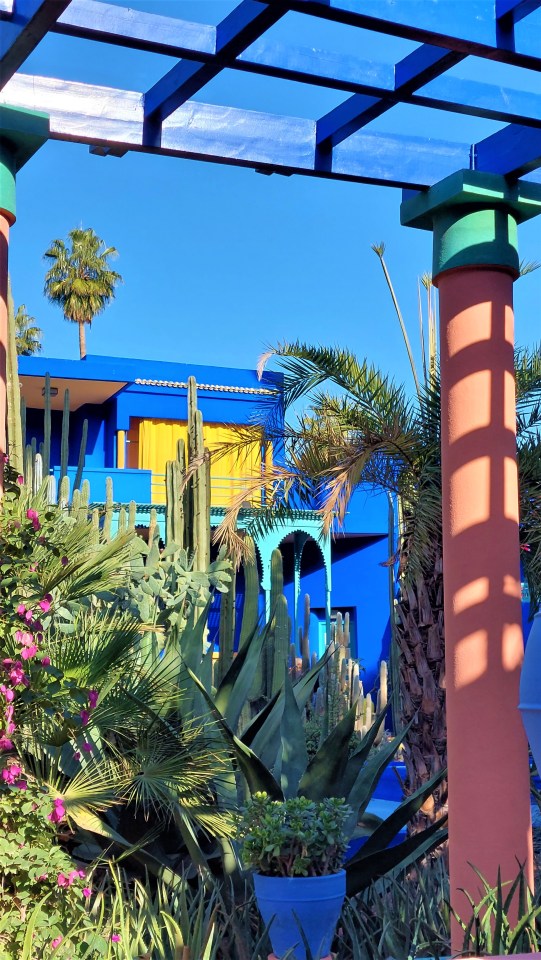
Jardin Marjorelle
Was auf den Tisch kommt
Pastilla – Traditionelles Festessen. Der Teig wird mit Fleisch, Huhn oder Tauben gefüllt, dazu reichlich Gemüse
Harira – Passierte Gemüsesuppe, darin Bohnen, Linsen, Kichererbsen, nebst allen Gewürzen des Orients
Tajine – In einem tönernen, zylindrischen Gefäß schmurgelt Fleisch und Gemüse so lange, bis es zu einem göttlich-saftigen Eintopf gegart ist
Tanjia – ähnlich wie oben, nur dass das Schmorgut in eine Amphore gefüllt wird, die an ihrer Oberseite verschlossen ist
Fladenbrot
Danach - Jede Menge Süßigkeiten und frisches Obst
Zum Trinken - Thé à la menthe, Tafelwasser


Im Jardin Marjorelle & Museum Yves St. Laurent
Vergils Weg
Ein Spaziergang durch die Stadt gleicht einer Reise auf den Spuren des Dichters Vergil durch Dantes „Göttliche Komödie“. Wo sonst durchmisst man „Inferno“, „Purgatorio“ und „Paradiso“ in so kurzer Zeit wie hier. Der Platz „Jamaa el Fna“, die Attraktion des touristischen Marrakeschs, liegt im Zentrum der Altstadt und fungierte in früheren Zeiten als Richtstätte. Am „Platz der Zerstörung“ wurde geköpft und gehenkt was das Zeug hielt. Wo, wenn nicht in einem Land, in dem Religion und Staat eine Allianz bildet, liegt Tat und Strafe nahe beisammen, und das sensationslüsterne Volk sieht dabei zu. Abschrecken heißt Vorbeugen. Den Richtern war’s recht, und die Henker wallten ihres Amtes. Kaufleute, Zahnbrecher, Gaukler, Schlangenbeschwörer und Garküchenbetreiber tummelten sich auf dem riesigen Platz und machten zur Richtstunde ihr Geschäft. Die Symbiose zwischen Tod und Leben war im Halsumdrehen geschaffen, und sie hält bis heute an. Zwar kamen in neuerer Zeit ein paar Fruchtsaftbuden und Folkloretänzer hinzu, das Gesetz des Überlebens aber ist unverändert. Wer der Touristenhölle mit Leib, Leben und gesundem Geldbeutel entkommt, hat es geschafft, ins Fegefeuer – verlangt doch der Weg zur Erlösung dem Wanderer noch eine weitere Prüfung ab.

Affenshow am Jemaa el Fna
In Marrakesch entspricht die labyrinthische Medina, vulgo „Souk“, dem Überwinden Dantes „Purgatorio“. Die mittelalterliche Shopping-Mall hat es in sich. Gnadenlos wird der Fremde dem Zauber orientalischer Verführungskunst ausgesetzt. Das Halali ist eröffnet, denn kaum setzt der Büßer seinen Fuß in die vom Tageslicht fahl beleuchteten Gänge, überfällt ihn eine, alle Sinne betäubende Flut an Gefahren und Gerüchen: Abgaswolken von Mopeds, verdauende Esel, umstürzende Gemüsekarren, Botenläufer, die sich ihren Weg freispucken, Essensgerüche, Parfümschwaden, und der beißende Geruch von Garküchen: Das Fegefeuer hält für jeden etwas bereit, und seien es auch nur Helping Hands, die flink nach Rucksäcken greifen. Daneben Waren aller Art: Fleisch, Teppiche, Silberwaren, Gewürze, Lederpantoffel, Krimskrams und Kokolores. Wer will noch mal, wer hat noch nicht. Verängstigt taumelt der Hilfesuchende durch das Chaos, indes sich Trauben von Ortskundigen mit ihm verbrüdern, um gegen kleines Geld den Weg zu weisen. Und längstens dann entgeht man alttestamentarischer Strafe nicht, denn das „Quartier des Tanneurs“, das Gerber-Viertel ist erreicht. Der Gestank, der einen hier erwartet und in dem die Ärmsten der Armen ihrer erbärmlichen Arbeit nachgehen, bleibt unvergesslich. Hier heißt es: Nase zu und durch! Vorbei am „Musée du Parfum“ oder dem „Maison de la Photographie“, stolpert man endlich einem der mächtigen Medina-Tore zu, und, wenn man Glück hat, eröffnet sich einem dort das goldene Licht des zu Ende gehenden Tages.
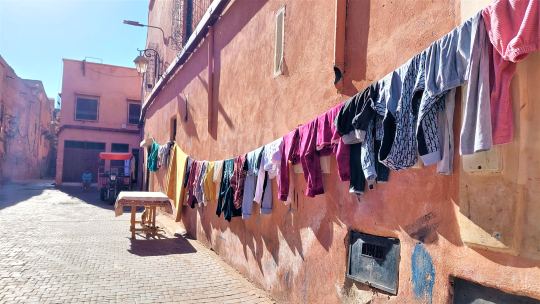
Im jüdischen Viertel von Marrakesch
„Gueliz“ heißt das schicke Viertel der alten Königsstadt. Palmen-Alleen, blühende Jacaranda-Bäume, Villen inmitten prachtvoller Gärten, übersät mit Bougainvilleas. Hier wohnt, wer es sich leisten kann. Mit der mittelalterlichen Innenstadt hat dieser Stadtteil nichts zu tun. Ein französischer Modeschöpfer hat hier vor Jahren nach der Sehnsucht Ausschau gehalten – und sie gefunden. Der „Jardin Majorelle“ ist eine Offenbarung aus Natur und Poesie, ein Garten der Inspiration, angelegt vom Malerfürsten Jacques Majorelle, Jahre später verfeinert vom Genius Yves Saint Laurent mit Sinn für das Schöne und Teure. Hier fühlt sich der nach Erlösung Suchende am Ziel: Bambushaine, Agaven, Wasserbecken, exotische Hölzer, Blumen und Kakteen – und eine „Villa“, die die Pracht Arkadiens in den Schatten stellt. Das Abendrot Marokkos lässt die Farben des Modeschöpfers noch leuchtender erstrahlen, als sie es ohnehin schon sind: Blau, Orange, Mauve, Gelb. Nirgendwo möchte man länger verweilen als eben hier. Der Weg Vergils ist beschritten, das „Paradiso“ erreicht.
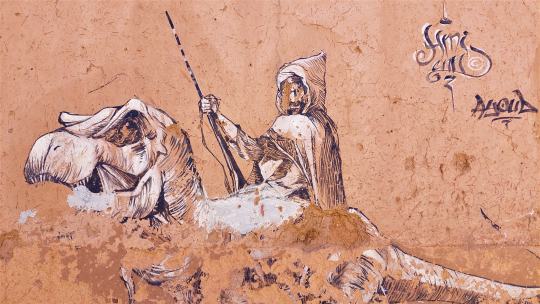
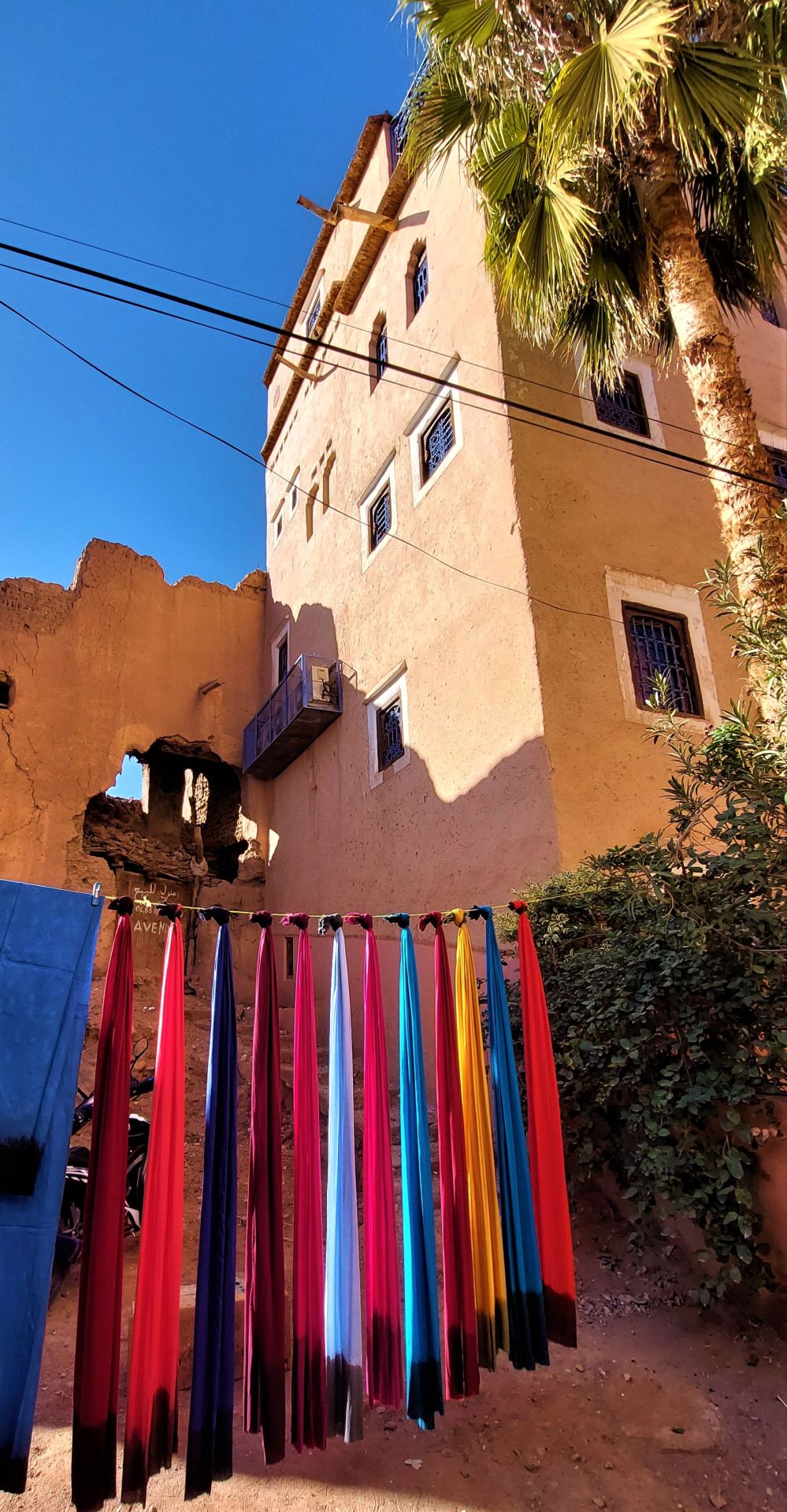
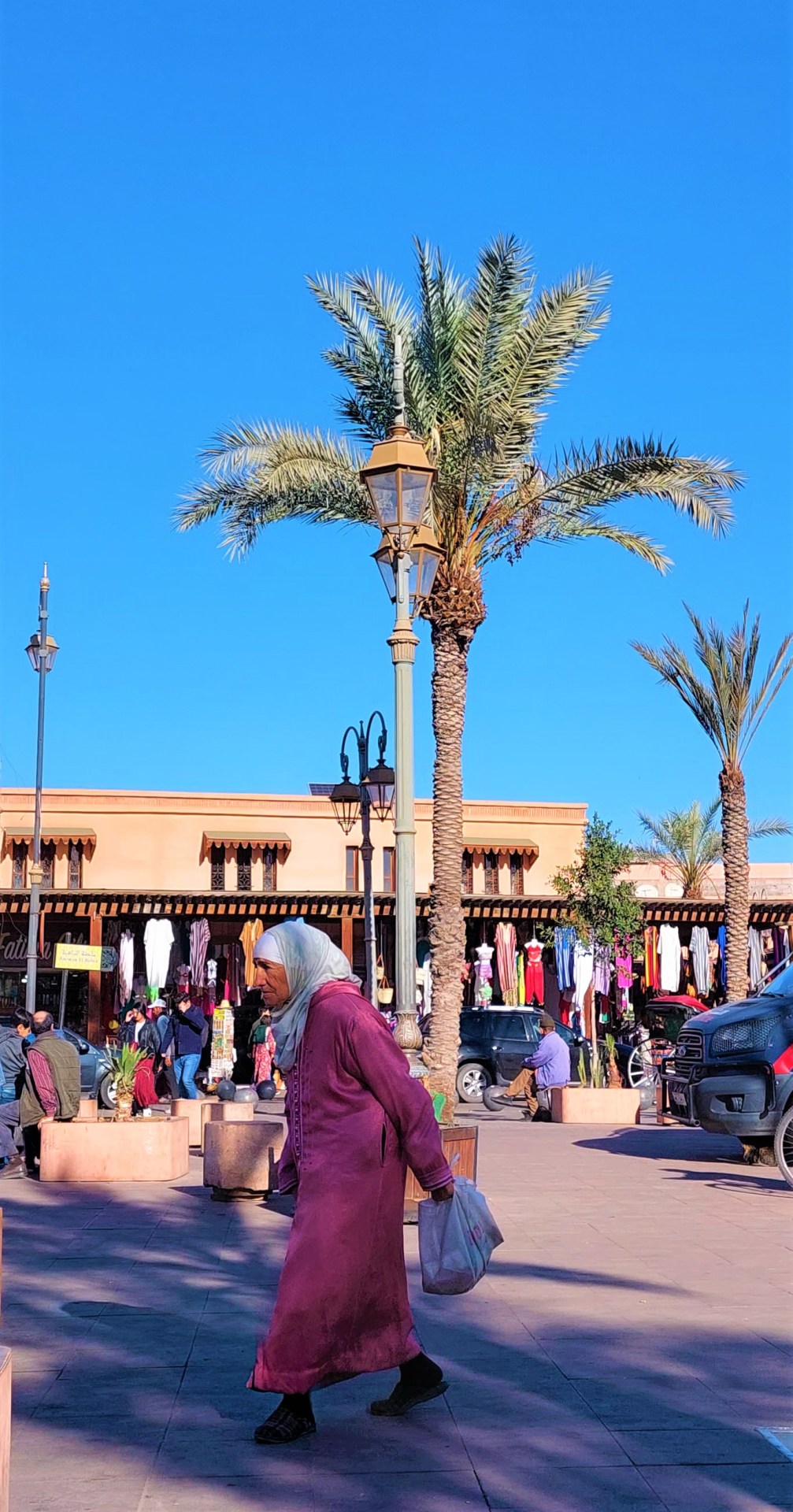
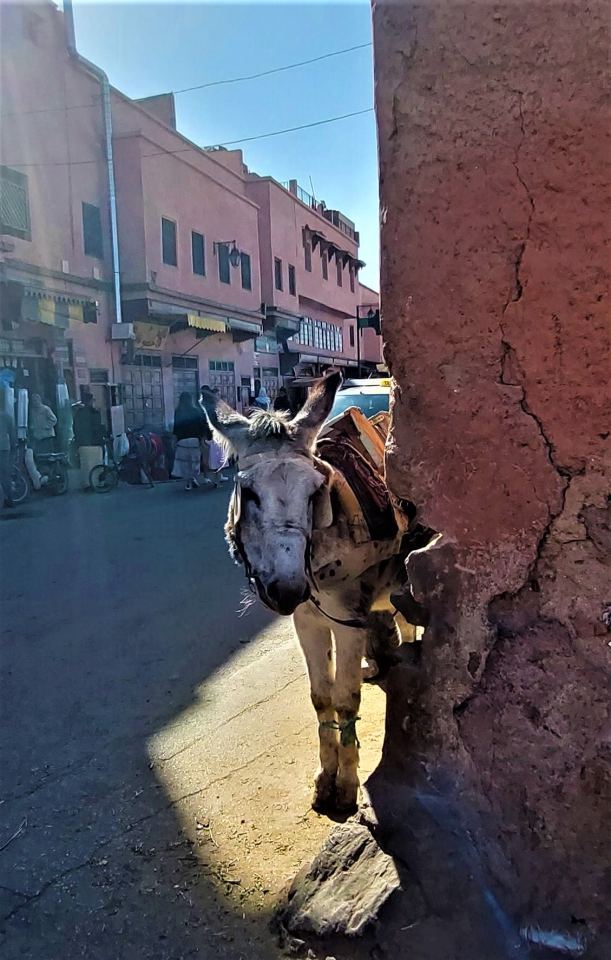



#michael schottenberg#schotti#schotti unterwegs#schotti to go#orf#Studio 2#Marrakesch#Marokko#Jemaa el Fna#Bahia Palast
3 notes
·
View notes
Text

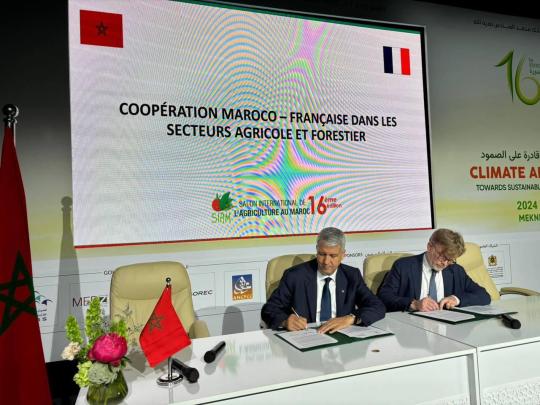

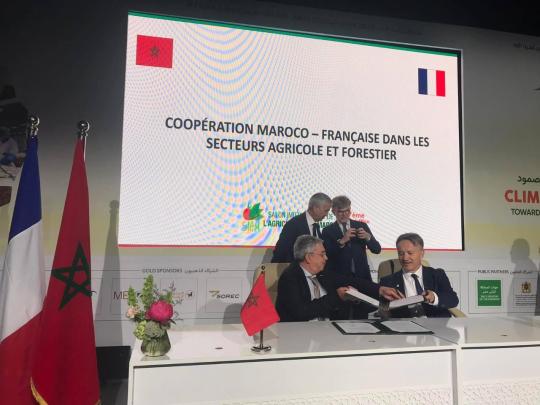
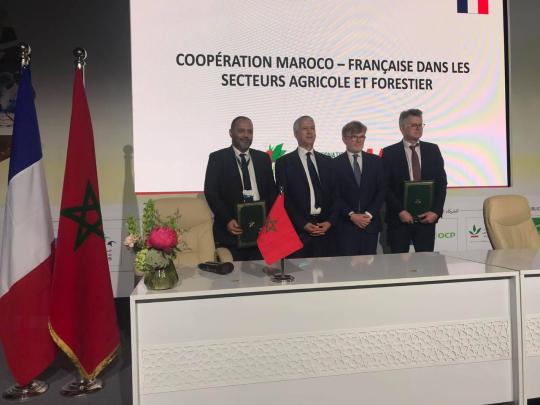

Marc Fesneau, accompagné des dirigeants d’interprofessions, de filières et d’entreprises agricoles françaises, est à Meknès au Maroc pour participer à l’inauguration de la 16e édition du Salon international de l’Agriculture au Maroc (SIAM), à l’invitation de Mohammed Sadiki, ministre marocain de l’Agriculture, de la Pêche maritime, du Développement rural et des Eaux et Forêts.
Lundi 23 avril 2024
Photos agriculture.gouv.fr
0 notes
Text

A distanza di un anno sono tornato in Marocco. Nel 2023 percorsi tutta la costa all'estrema punta settentrionale del paese: da Cap Spartel a Ceuta, passando per Tangeri, fino a scendere in quel gioiello blu di Chefchaouen. Nei giorni scorsi ho ripreso il mio viaggio a ovest, sostando, dopo Salè, nella capitale Rabat - una delle quattro città imperiali insieme a Fes, Marrakech e Meknès - adagiata sulla sponda opposta del fiume Bou Regreg. Venerdì, mentre scendevo dalla bellissima Kasbah degli Oudaïa, poco prima dell'arrivo della tempesta, ho fotografato un tramonto sull'Oceano Atlantico che mi ha lasciato un'altra cicatrice addosso. Come tutte le cicatrici fresche, continuo a guardarla e sfiorarla, specialmente la sera, quando, stremato dai chilometri percorsi, mi riposo nel Riad e ascolto le voci della città. Sono qui in pieno Ramadan. L'adhan, il canto del muezzin che si diffonde tra le stradine labirintiche dei suq, è un suono affascinante e suggestivo; la preghiera serale, sembra spalancare le porte al silenzioso arrivo del sonno. Che magia è questo angolo di terra. Così diverso, così lontano, ma in realtà anche così simile, poiché come il nostro, fatto di uomini, di cuori, di vite. Ancora una volta, mi sono perso - letteralmente - nei vicoli della medina, rapito dai volti segnati delle persone, dai loro occhi profondi, da colori e suoni ammalianti. Quante persone ho incontrato. E con quante ho scambiato frammenti di vita.
Adesso, però, è giunto il momento di tornare a casa. Prima di spegnere il laptop voglio finire di scrivere alcuni pensieri, solo poche righe, poi andrò nel vecchio souk a godermi un ultimo tajine di carne e verdure che qui cucinano divinamente. In questi giorni, proprio per via del Ramadan, ho mangiato solo dopo le 20:00 perché i ristoranti hanno orari diversi. Delizioso il Dar Rbatia con la sua cucina tipica marocchina, ma la cena a Le Dhow (tradizionale imbarcazione araba in legno) è stata la più bella. Luci calde e fioche, poche persone, qualcuna leggeva un libro. Fuori, solo il rumore della pioggia.
Mi fermo qualche minuto a chiacchierare con Ahmed e Hadid del Dar Yanis, il Riad che mi ha ospitato. Ahmed non vuole neanche i soldi dell'ombrello che mi ha prestato l'altro ieri per uscire con il nubifragio e che io ho riportato a brandelli. Quando mi ha aperto il portone e mi ha visto zuppo dalla testa ai piedi, ha riso come un bambino 𝘔𝘺 𝘧𝘳𝘪𝘦𝘯𝘥, 𝘤'𝘦𝘴𝘵 𝘭𝘦 𝘔𝘢𝘳𝘰𝘤. Sì perché da giorni di sole e cielo limpido, sono passato ad altri fatti di diluvio universale. Le raffiche di vento che arrivano dall'Atlantico sono impetuose, tanto da spostarti mentre cammini in prossimità della costa. Fuori dal museo nazionale della fotografia, ho preso acqua dal cielo e dall'oceano contemporaneamente.
Infine, non posso lasciare questo luogo a Rabat senza salutare la mia vicina di tavolo durante la colazione. Una signora danese di estrema raffinatezza, che insieme alla sua compagna di origini marocchine, è in viaggio per gran parte del paese. Le guardo, sono così diverse tra loro, eppure in perfetta sintonia, complici. Lei più influente, trasuda nobiltà nei modi, mentre l'altra è piena di vitalità ed energia. Tanti anni di differenza, tanti racconti nel salon. Mentre io mi preparo a fare ritorno a Roma, loro proseguiranno domani per Casablanca.
𝙵𝚘𝚝𝚘 𝚎 𝚛𝚊𝚌𝚌𝚘𝚗𝚝𝚒 𝚍𝚒 𝚁𝚊𝚋𝚊𝚝 𝚗𝚎𝚕𝚕𝚎 𝚜𝚝𝚘𝚛𝚒𝚎 𝚒𝚗 𝚎𝚟𝚒𝚍𝚎𝚗𝚣𝚊 𝚜𝚞 𝙸𝚗𝚜𝚝𝚊𝚐𝚛𝚊𝚖. 𝙻𝚊 𝚜𝚒𝚝𝚞𝚊𝚣𝚒𝚘𝚗𝚎 𝚖𝚎𝚝𝚎𝚘𝚛𝚘𝚕𝚘𝚐𝚒𝚌𝚊 𝚖𝚒 𝚑𝚊 𝚕𝚒𝚖𝚒𝚝𝚊𝚝𝚘 𝚖𝚘𝚕𝚝𝚘 𝚗𝚎𝚕𝚕'𝚞𝚜𝚘 𝚍𝚎𝚕𝚕𝚊 𝚛𝚎𝚏𝚕𝚎𝚡.
Viaggiare è come un'accelerazione del tempo, una corsa attraverso paesaggi mutevoli e culture diverse che ci ricorda quanto rapidamente la vita scorra davanti ai nostri occhi. Ogni nuova destinazione, ogni incontro, ogni esperienza è un tassello aggiunto al mosaico della nostra esistenza. In questo movimento incessante, mi rendo conto che ogni istante speso nel viaggio è un momento che non tornerà mai più. Perciò, viaggiate ed esplorate, cogliete ogni opportunità, perché la vita passa velocemente e attraverso il viaggio si può assaporare un po' di più la sua fugace bellezza.
0 notes
Text
FES, MEKNÈS, CHEFCHAOUEN 🇲🇦 4 Days
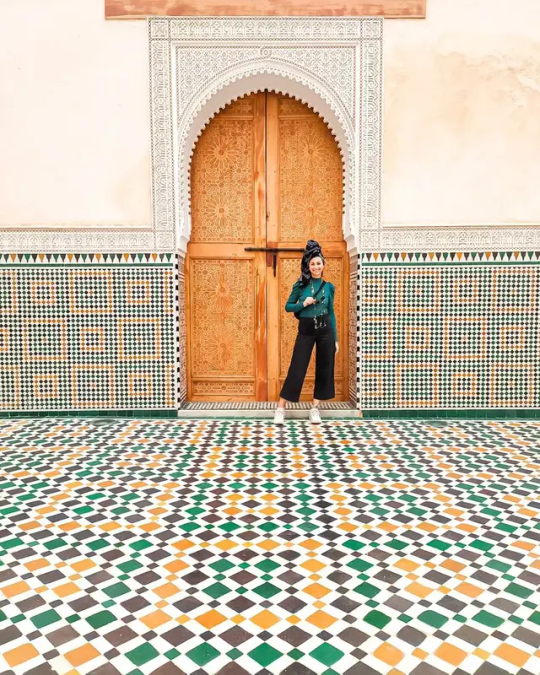
The oldest of the four "imperial cities" of Morocco (the others are Marrakech, Meknes and Rabat), Fes was the capital of Morocco several times in the past, the last of which ended in 1912, when most of Morocco came under French control and Rabat was chosen to be the capital of the new colony. Today Fes is the third largest city in Morocco after Casablanca and Rabat.
Fes is often referred to as the spiritual capital of Morocco. It was once one of the most important places of scholarship in the world, containing within its walls the bastion of Islamic teaching. The University of Al-Karaouine was founded in 859 AD and is the oldest continuously-operating university in the world.
WHAT TO VISIT
CHOUARA TANNERY
Colorful Moroccan slippers, bags, and jackets are just some of the leather goods available in Fes. But before shopping, be sure to check out the world-famous tanneries to see the traditional dying of animal skins

The ancient MEDINA
WATER CLOCK
UNIVERSITY
The Kairaouine Mosque is known to be the world’s oldest university and is the second-largest mosque in Morocco. It is one of the most important religious buildings in Fes, and as such, only Muslims are allowed inside.
Explore the SOUKS
The souks are the very soul of any Moroccan city, and the ones in Fes are some of the most impressive. Step back into a medieval time of dusty walled streets, where the only transport is donkey and cart. It’ll be an assault on the senses, with sellers shouting prices and striking hard bargains, aromatic smells coming from every direction, and textile displays in all colors of the rainbow.
NEJJARINE FONDOUK
Right amid Place Nejjarine, surrounded by metalworker workshops, you'll find the Nejjarine Museum in an old fondouk (khan or caravanserai), which has been transformed into a museum exhibiting the diversity of traditional Moroccan wooden arts and crafts
VISIT THE BAB BOUJELOUD (BLUE GATE)
The Bab Boujiloud is the iconic blue gate that marks the entrance to Fes el Bali (Old City). You can also check out the Bab Chorfa, another impressive gate framing the Medina.

WHERE TO STAY/WHERE TO EAT
We stayed at Riad Dar Omar
Here some places where to eat:
Cafè Clock
Restaurant Sahra
DAILY TRIPS FROM FES
MEKNÈS 📍
Only 65 kilometers southwest of Fes, and connected by regular trains, Meknes is a favorite day-tripping destination for visitors to the city.
This imperial city, made the ruling capital by Sultan Moulay Ismail in the 17th century, is home to a compact medina area that offers a more relaxed sightseeing experience than the crowded medinas of Fes and Marrakesh. This allows for easier viewing of the alleyway architecture.

Neighboring the medina is Meknes' imperial district, home to the grand Bab al-Monsour, one of the most ornate surviving gateways in North Africa, and the Mausoleum of Moulay Ismail, with its fine tile work and stucco-decorated interior.

Meknes is also the closest city to Volubilis, Morocco's best Roman-era ancient site. The rambling hilltop site, only 32 kilometers north of Meknes, is home to half-toppled temple buildings, still-standing columns along a colonnaded street, and intricate mosaic floors.
If you start early enough from Fes, it's easy to combine both in one day. Daily trip for 25€ each.
2. IFRANE NATIONAL PARK 📍
Ifrane National Park is located in the northcentral part of Morocco. It is situated in the central part of the Atlas mountain range. The park covers an area of 193.05 square miles (500 sq km).
The mountainous national park is blanketed in many parts with the Atlas cedar trees. Wetlands, high-altitude forests, and endemic habitats are part of what make the national park such a vital protected area.
The altitude of the park ranges from 4,590 to 7,874 (1,300 to 2,400 m) above sea level. The higher mountains are located in the neighboring Toubkal National Park which features the famous Mount Toubkal.
Approximately a tenth of the world’s population of Atlas Cedar is located here in the park. The ecosystem is also home to the endangered Barbary Macaque with approximately 25% of the entire global population found here in Ifrane. Daily trip for 25€ each.
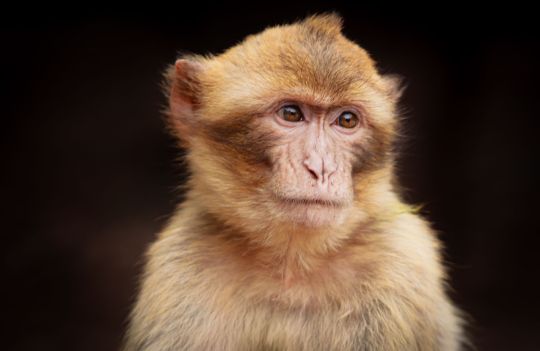
3. CHEFCHAOUEN 📍
Chefchaouen is a small town in Morocco with a rich history. Nestled in the Rif mountains, this old town is known for its beautiful surroundings and architecture, but what makes it stand out are the striking and varying shades of blue walls – it is one of The Most Colorful Cities Around The World.
Moulay Ali Ben Moussa founded the town of Chefchaouen in 1471. It began as a small fortress to fight the Portuguese invasions of Morocco. The Ghomara tribes, Moriscos, and Jews settled down in it after the Spanish Reconquista in 1492. Later, in 1920, Spain seized the old town, and it became a part of Spanish Morocco. Then, finally, Morocco declared its independence in 1956, and Chechaouen rejoined it once again.

The Reasons Why The City of Chefchaouen in Morocco is Entirely Blue:
The Jews
The color blue is representative of the sky according to Jewish belief. Jewish communities, therefore paint things blue and use blue-colored fabrics, especially prayer mats.
People believe that the Jewish refugees spread the blue fever to the entire ‘medina’ in 1930. The practice of painting walls blue was introduced by the Jews to stick to their religious practices. However, older residents say that the majority of the buildings within the medina used to be white until fairly recently. They stress that only the Jewish part of the medina used to be painted blue.
The Mosquitoes
A part of the residents believes that the blue shades repel mosquitoes. Their reasoning is that the insects do not like being in the water, although they live near the water. The blue walls almost look like flowing water, and they believe that this aspect keeps away the mosquitoes.
It is certainly possible that residents saw fewer mosquitoes in the Jewish part of the town, and so they decided to attribute it to the color and paint their houses blue as well.
Daily Trip from Fes for 30€ each.
0 notes
Text
مباراة توظيف 3 مناصب بالمدرسة الوطنية للفلاحة بمكناس. آخر أجل للتقديم هو 8 مارس 2024
هذا موضوع عن مباراة توظيف 3 مناصب بالمدرسة الوطنية للفلاحة بمكناس. آخر أجل للتقديم هو 8 مارس 2024 اليكم التفاصيل:
Concours Ecole Nationale d’Agriculture de Meknès 2024
L’Ecole Nationale d’Agriculture de Meknès ENAM organise un concours pour le recrutement de 3 postes répartis comme suit
(2) Ingénieurs 1er grade.(1) Administrateur 2ème grade.
Le dernier délai pour postuler est le 8 Mars…

View On WordPress
0 notes